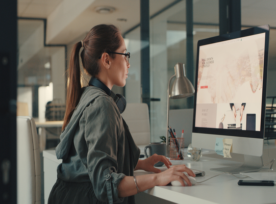Product teams should be keen to understand how people interact with digital content and media. For one, web users’ interactions with website content changes over time. Two, it changes by situation. And three, it changes by ability. For example, what a web user can do in her 20’s, such as navigating web pages with a mouse, […]
Posts Tagged ‘UX for Accessible Design’
Plan to be Accessible by Design: Accessibility in the Product Development Lifecycle Part 1 of 4
Accessible Product Development Starts with Shift Left Using a Shift Left method to improve product development outcomes isn’t new or novel. Shift Left has been adopted for decades to lower software development refactoring time and costs and streamline time to market by testing software earlier in the design process and not just before it ships. […]
POUR: Designing for Accessibility with Robustness in Mind
We’ve come to the final post in this series on the W3C’s Principles “POUR,” designing and coding for the “Robust” principle. In the context of technology, a solution is robust when it comes with a wide range of capabilities, or is able to deal with many different situations. Robust solutions should be navigable and usable […]
POUR: Designing for Accessibility With Understandable in Mind
The W3C organization developed four core principles to help designers and developers ensure websites, mobile apps, and all interactive media would be perceivable, operable, understandable, and robust (POUR) to as many digital users as possible. These four principles are as relevant today as they were when Tim Berners-Lee founded the W3C in 1994. In an […]
POUR: Designing for Accessibility With Operable in Mind
“POUR” has become mainstream lingo for the four main principles (Perceivable, Operable, Understand, and Robust) of web accessibility. These four essential guidelines created by the W3C organization are the “how-to” guide for digital teams of strategists, designers, developers, SEO, and content specialists to create accessible experiences. These guidelines were created so that digital consumers using […]
POUR: Designing for Accessibility With Perceivability in Mind
Designing for accessibility is both a mindset and a design practice. Together, they strive to make various forms of technology accessible to people as much as possible by minimizing or eliminating barriers to information through our senses (hearing, vision, and touch). The ability to access digital content every day should not be difficult for anyone […]
Create More Accessible Web Design for Disability Using These 3 Scenarios
Web accessibility is important for people with disabilities, especially now due to the COVID-19 pandemic. People are doing more and more online, from ordering groceries, to medications, and even car shopping. In today’s world, it seems that anything can be ordered online, and for most people, it can. But for individuals with disabilities, it may […]
The Beauty of Simplicity: The Key to Accessible Web Design
In today’s hectic world, humans are increasingly drawn to simplicity. Stemming from a rising need for everyday efficiency and speed, we are in constant search for the next new technology that will make our lives easier. While this inclination toward simplicity is likely intuitive for most aspects of modern life, we often see the opposite […]
A Process Integration Timeline of Accessibility Testing
All too often, accessibility does not cross the mind of designers or developers until it is too late in the process. Approaching accessibility as a final checkbox in the entire process of a webpage and website development will result in exurbanite defects and adversely affect the final product. Developers and designers must take on the […]
It’s a Program, Not a Project: Designing Websites for Accessibility
Many companies view accessibility remediation as a one-off project or a parallel effort to their current development life cycle. In fact, it is the opposite. Accessibility should be integrated into your overall design process from the very beginning. It’s important to focus on the benefits and advantages of “shifting left” and incorporating accessibility into the […]
Understanding Disability Types for Effective UI Design: 3 Key Factors for Empathetic Problem-Solving
The Assumptions We Make About Disability What comes to mind when you’re thinking about what it means for a person to be disabled? Are they deaf? Is their mobility compromised in some way? What about their vision? It’s important to remember that senses and abilities like these aren’t only reserved for those with permanent disabilities. […]










